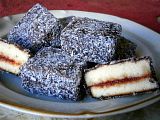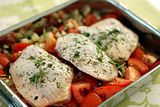
Wednesday, June 30, 2010
Bread Baking Day # 31 : Bread with Nuts

June BOM Bagels

Adapted from Peter Reinhart’s The Bread Baker’s Apprentice by blossomtostem.net; further adapted by your host.
Sponge
1/2 teaspoon (.055 ounce/1.56 grams) instant yeast
2 cups (9 ounces/255 grams) high-gluten flour
1 1/4 cups (10 ounces/295 milliliters) water, at room temperature
Dough
1/4 teaspoon (.028 ounce/.8 gram) instant yeast
1 3/4 cups +2 tablespoons (8.5 ounces/240 grams) high-gluten flour
1 1/4 teaspoons (.3 ounce/8.5 grams) salt
1/2 tablespoon malt syrup, honey, or brown sugar (or 1 teaspoon diastatic malt powder)
Finishing Touches
1 tablespoon baking soda
cornmeal for dusting
optional toppings: sesame seeds, poppy seeds, kosher or sea salt, cinnamon and sugar, etc.
A day (or two) before you want the bagels (see below for instructions on making the bagels in one day):
Prepare the Sponge.
In a large bowl (if using a stand mixer, go ahead and start it in that bowl) mix 1/2 teaspoon yeast, 2 cups high-gluten flour, and 1 1/4 cups water until it forms a thick batter. This is a very stiff dough, so hand mixing and kneading is recommended. Cover with plastic wrap and let sit until bubbly, nearly doubled in size, and on the verge of collapse, about 2 hours.
Make the Dough.
Add 1/4 teaspoon instant yeast to the sponge and stir. Add the salt, malt syrup or powder, and 1 1/2 cups flour. If using a stand mixer, mix on low speed for about 2 minutes, or by hand for a few minutes or until a dough ball has formed. Slowly add the remaining flour, and mix on medium speed for 6 minutes (or knead by hand for about 10 minutes) or until all of the flour is incorporated. The dough should be smooth, stiff, stretchy, and not sticky or tacky. If the dough feels dry and tears easily when stretched, add a little water, a teaspoon at a time, and knead some more. If the dough feels sticky, add some flour.
Divide and Shape the bagels.
Line a sheet pan with parchment paper and spray lightly with oil. Divide dough into 2 3/4 to 3 ounce pieces, or, if you don’t have a scale, into 9 equal pieces. Roll each piece into a ball, place on parchment, cover with a damp towel and let rest for 20 minutes. With your finger or thumb, poke a hole in each piece and stretch to about 2 inches in diameter. Try to stretch the dough evenly to avoid thick and thin spots. Place on parchment, cover with a damp towel, and let rest for 20 minutes. To test to determine whether the bagels are ready to go into the refrigerator, fill a medium bowl with cool water. Drop one of the bagels into the water. It should float within 10 seconds. If it doesn’t, pat the bagel dry, return to parchment and let rest for another 10 minutes before testing again. If it does float, pat the bagel dry, cover the baking sheet with plastic wrap. Be careful to create an airtight seal, otherwise the bagels could dry out. Place in the refrigerator overnight (or for up to two days).
If you want to bake the bagels on the same day, after shaping them, let them rest covered for 30 minutes, then proceed with boiling and baking.
On the day you want the bagels (one or two days later):
Get everything ready.
Preheat the oven to 500°F. Line a baking sheet with parchment paper and mist with oil and dust with cornmeal. Bring a large pot of water to a boil, and add the baking soda. Have a slotted spoon ready. If you are topping with seeds or salt, have those out and ready.
Boil.
Remove the bagels from the refrigerator. Place a few bagels into the boiling water. Be careful not to overcrowd the pot–the bagels will puff up a bit in the water. Boil for 1 minute, then turn the bagels over and boil for another minute. Place on prepared parchment. If using seeds or salt, top when the bagels come out of the water. Repeat with the rest of the bagels.
Bake.
Place baking sheet on the middle rack on the oven and bake for 5 minutes. Reduce heat to 450°F, rotate the baking sheet 180° and bake for an additional 5-8 minutes, or until tops are golden brown. Remove from the oven and cool on racks for about 15 minutes. If topping with cinnamon and sugar, brush tops of bagels with butter just after they come out of the oven and sprinkle with cinnamon and sugar mixture and let cool.
Yields 9 bagels.

In Memory of Rosie
Today it’s been forty days without Dear Jules, aka Rosie of Baking Cakes Galore, who left us quite unexpectedly of heart attack. This event was created to honour Jules but also to bring awareness about heart diseases and the best cure is to know what causes it and how to prevent it.
As much as I hate repeating myself, I am going to tell you not only to look after your own health, but since WE are responsible for putting food on the plate to feed our families we should think twice of what to eat and what not to eat.
According to Mayo Clinic, heart disease may be the leading cause of death for both men and women, but that doesn’t mean you have to accept it as your fate. Although you lack the power to change some risk factors — such as family history or age — there are some key heart disease prevention steps you can take.
Take steps to avoid heart disease — don’t smoke, get regular exercise and eat healthy foods. Avoid heart problems in the future by adopting a healthy lifestyle today.

What Is Coronary Artery Disease?
Coronary artery disease (CAD), also called coronary heart disease, is a condition in which plaque (plak) builds up inside the coronary arteries. These arteries supply your heart muscle with oxygen-rich blood.
Plaque is made up of fat, cholesterol (ko-LES-ter-ol), calcium, and other substances found in the blood. When plaque builds up in the arteries, the condition is calledatherosclerosis (ATH-er-o-skler-O-sis).
What Causes a Heart Attack?
Most heart attacks occur as a result of coronary artery disease (CAD). CAD is the buildup over time of a material called plaque on the inner walls of the coronary arteries. Eventually, a section of plaque can break open, causing a blood clot to form at the site. A heart attack occurs if the clot becomes large enough to cut off most or all of the blood flow through the artery.
National Heart, Lung & Blood Institute
This is the what Ivy wrote when she organized this event in honor of Rosie Actually it's thanks to Rosie if I met Ivy because I joined the Sweet and Simple Bakes group that Rosie had created with Maria and between all the bakers I met Ivy.
I never met Rosie but I feel that I did, only from the contacts we had thanks to internet.She was so kind and nice to everybody that I was very sorry to hear she was unwell and I couldn't even imagine it could be true she was not with us any longer.

I decided to make healthier puffs to make my previous Profiteroles lighter.
I got the recipe from Luca Montersino a very health-conscious Pastry Chef.

RECIPE
(from Le Dolci Tentazioni)
Bring to a boil 260 gr organic sunflower oil
with 320 gr water and a pinch of salt.
Add 160 gr all purpose flour all together
and mix for at least a minute until the dough forms a ball (I added some flour because it looked very oily and nothing bad happened)
Put the dough in a mixer and add 70 gr egg whites followed by 390 gr of whole eggs.
Form the puffs, either with a spoon or with a sac a poche and cook in a 220° oven until golden.
I noticed the puffs tend to dry sooner than the ones made with butter so fill right away or freeze in an airtight bag.

Bread Baking Buddies : Korni

1 cup boiling water (235 g)
2 1/2 cups warm water (2 1/4 cup = 533 g)
1 cup organic rye flour (100 g)
1 cup organic whole wheat flour (130 g)
1 1/2 cups organic unbleached white (or all-purpose) flour (180 g)
1/4 cup warm water (60 g)
3 cups organic, unbleached white (or all-purpose) flour (420 g)
1 tablespoon sea salt (2 tsp)
1 tablespoon ground caraway seeds* (1 tsp)
1/4 cup organic flax seeds (37 g)
1/2 cup organic millet (100 g) All of the soy mixture
Prepare the soy beans:
Place them in a small bowl, cover them with the boiling water, and let them soak for 10 minutes. Drain the beans and let them cool. Process the beans in a food processor fitted with the metal blade until they roughly chopped.
Place the beans on a cookie sheet and roast them in a preheated 350°F oven between 15 and 20 minutes, until they are completely dried out. Set them aside.
(to make your own, grind a few tablespoons of whole caraway seed in a mortar with a pestle until you have a fine powder. If your powder still contains large chunks of seed, sift the mixture and use 1 tablespoon of the sifted powder)
Prepare the sponge/poolish:
First proof the yeast, in a large bowl, in 1 cup of the warm water. When it is creamy, mix in 1 1/4 cups warm water and slowly add the rye flour, whole wheat flour, and 1½ cups of white flour by handfuls while stirring the mixture with a wooden spoon.
Set the batter aside, in a large bowl, covered with a dish towel, for between 8 and 10 hours or overnight.
Make the dough:
Proof the yeast in the warm water, add it to the risen sponge, and mix the two together. Start adding the flour, handful by handful, stirring vigorously with a wooden spoon. After all but 1 cup of the flour has been added (this will take about 10 minutes), turn the dough out onto your worktable, sprinkle the salt and the ground caraway over the dough, and incorporate them by kneading the dough for about 5 minutes while adding the last of the flour. The dough should be very moist.
Add the flax seeds, millet, and roasted soy beans and knead the dough to incorporate them.
Set the dough aside, covered, to rise for 1 hour, until it has doubled in size.
Flatten out the dough again and then shape it into a round loaf. This loaf is best proofed in a canvas-lined basket and then baked on a baking stone in the oven. It can also be placed on a parchment-lined baking sheet. Let the loaf rise for about 1 1/2 hours.
Glaze the loaf with the egg and milk mixture and bake it in a preheated 425°F oven for between 30 and 35 minutes.
(source: "The Village Baker" -Joe Ortiz)
TWD : Rum-Drenched Vanilla Cakes





























































































.jpg)













.jpg)





































